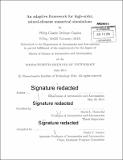| dc.contributor.advisor | David L. Darmofal. | en_US |
| dc.contributor.author | Caplan, Philip Claude Delhaye | en_US |
| dc.contributor.other | Massachusetts Institute of Technology. Department of Aeronautics and Astronautics. | en_US |
| dc.date.accessioned | 2014-10-08T15:20:45Z | |
| dc.date.available | 2014-10-08T15:20:45Z | |
| dc.date.copyright | 2014 | en_US |
| dc.date.issued | 2014 | en_US |
| dc.identifier.uri | http://hdl.handle.net/1721.1/90654 | |
| dc.description | Thesis: S.M., Massachusetts Institute of Technology, Department of Aeronautics and Astronautics, 2014. | en_US |
| dc.description | Cataloged from PDF version of thesis. | en_US |
| dc.description | Includes bibliographical references (pages 99-103). | en_US |
| dc.description.abstract | This work builds upon an adaptive simulation framework to allow for mixed-element meshes in two dimensions. Contributions are focused in the area of mesh generation which employs the Lk norm to produce various mesh types. Mixed-element meshes are obtained by first using the L[alpha] norm to create a right-triangulation which is then combined to form quadrilaterals through a graph-matching approach. The resulting straight-sided mesh is then curved using a nonlinear elasticity analogy. Since the element sizes and orientations are prescribed to the mesh generator through a field of Riemannian metric tensors, the adaptation algorithm used to compute this field is also discussed. The algorithm is first tested through the L² error control of isotropic and anisotropic problems and shows that optimal mesh gradings can be obtained. Problems drawn from aerodynamics are then used to demonstrate the ability of the algorithm in practical applications. With mixed element meshes, the adaptation algorithm works well in practice, however, improvements can be made in the cost and error models. In fact, using the L[alpha]-generated meshes inherits the same properties of traditional triangulations while adding structure to the mesh. The use of the L[alpha]-norm in generating tetrahedral meshes is worth pursuing in the future. | en_US |
| dc.description.statementofresponsibility | by Philip Claude Delhaye Caplan. | en_US |
| dc.format.extent | 103 pages | en_US |
| dc.language.iso | eng | en_US |
| dc.publisher | Massachusetts Institute of Technology | en_US |
| dc.rights | M.I.T. theses are protected by copyright. They may be viewed from this source for any purpose, but reproduction or distribution in any format is prohibited without written permission. See provided URL for inquiries about permission. | en_US |
| dc.rights.uri | http://dspace.mit.edu/handle/1721.1/7582 | en_US |
| dc.subject | Aeronautics and Astronautics. | en_US |
| dc.title | An adaptive framework for high-order, mixed-element numerical simulations | en_US |
| dc.type | Thesis | en_US |
| dc.description.degree | S.M. | en_US |
| dc.contributor.department | Massachusetts Institute of Technology. Department of Aeronautics and Astronautics | |
| dc.identifier.oclc | 890395535 | en_US |

